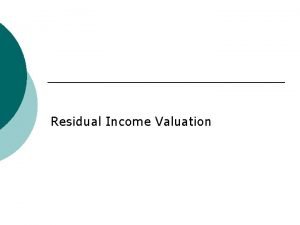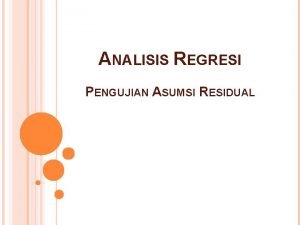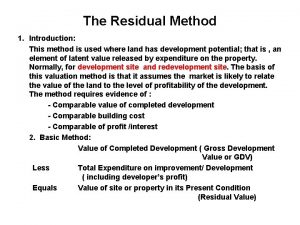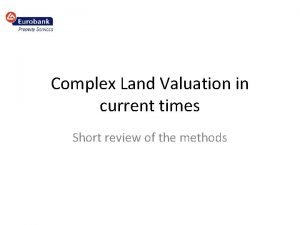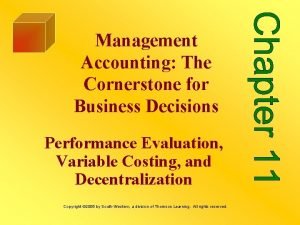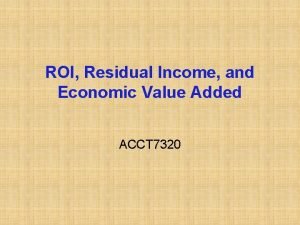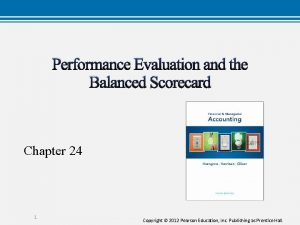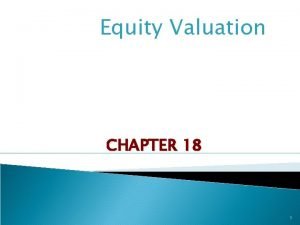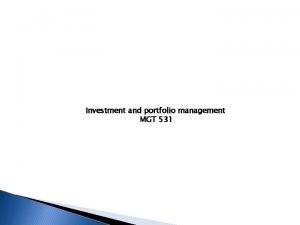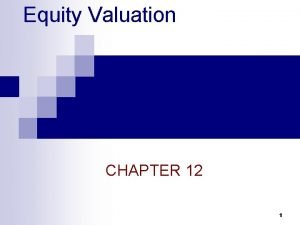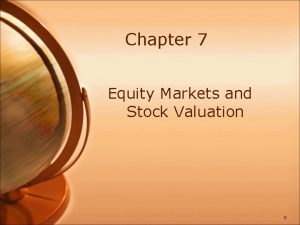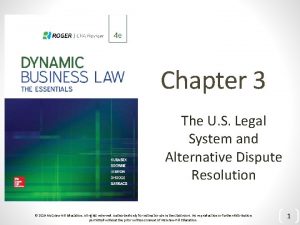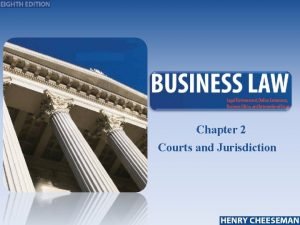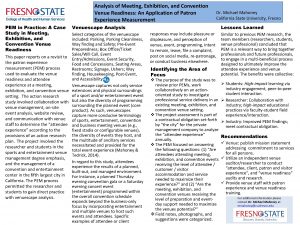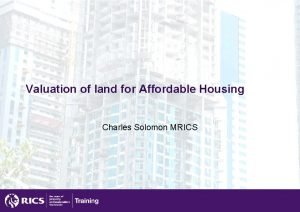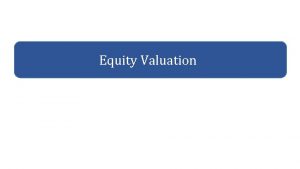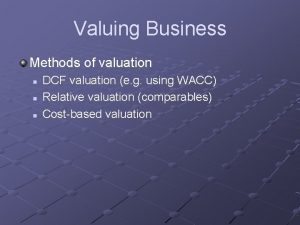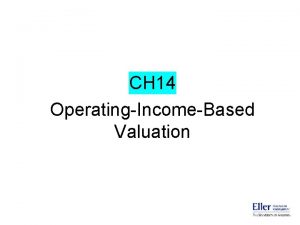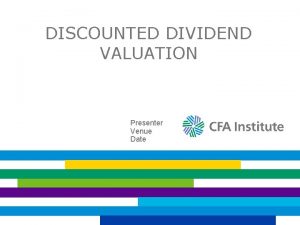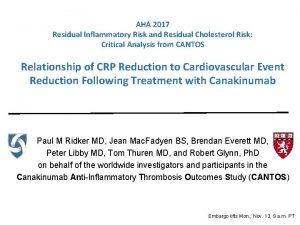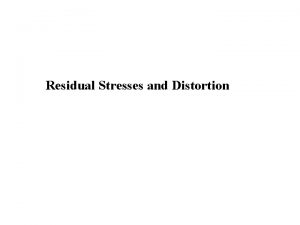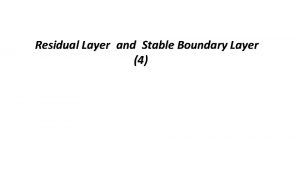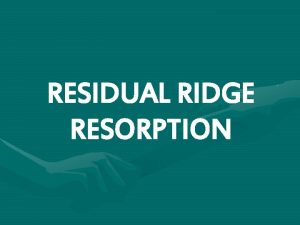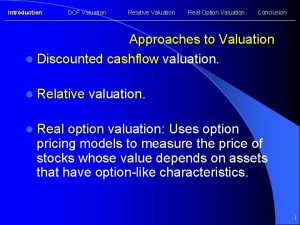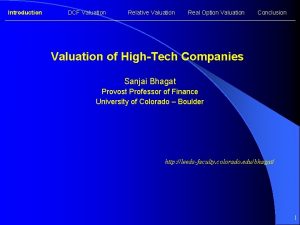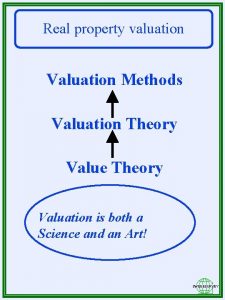RESIDUAL INCOME VALUATION VALUING COMMON EQUITY Presenter Venue







































- Slides: 39

RESIDUAL INCOME VALUATION: VALUING COMMON EQUITY Presenter Venue Date

RESIDUAL INCOME Economic Profit Abnormal Earnings Economic Value Added Residual Income

RESIDUAL INCOME Net Income Equity Charge Residual Income NOPAT Capital Charge Residual Income

EXAMPLE: RESIDUAL INCOME Total assets $5, 000. 00 Debt-to-total capital ratio 0. 60 Cost of debt (before tax) 8% Cost of equity 12% Tax rate 40%

EXAMPLE: RESIDUAL INCOME EBIT $400, 000 Less interest Expense $240, 000 Pretax income $160, 000 Less income tax expense $64, 000 Net income $96, 000

EXAMPLE: RESIDUAL INCOME Equity capital $2, 000 Equity charge $240, 000 Net income Less equity charge Residual income $96, 000 $240, 000 -–$144, 000

RELATED MEASURES Economic Value Added (EVA) NOPAT C% × TC - NOPAT = Net operating profit after taxes - C% = Cost of capital - TC = Total capital Market Value Added (MVA) Market Value of the Firm Book Value of Total Capital

USES OF RESIDUAL INCOME Valuation Measuring Goodwill Impairment Measuring Internal Corporate Performance Determining Executive Compensation

FORECASTING RESIDUAL INCOME Residual income per share Earnings per share (EPS) Required return on equity (Re) Beginning book value per share (BVPS)

EXAMPLE: FORECASTING RESIDUAL INCOME 0 1 2 Earnings $2. 50 $3. 00 Dividends $1. 00 $1. 10 Book value Required equity return $20. 00 10%

EXAMPLE: FORECASTING RESIDUAL INCOME IN ONE YEAR Charge for Equity Capital = • Required return on equity × Beginning book value per share • 10% × $20. 00 = $2. 00 Residual Income in Year 1 = • EPS – Charge for equity capital • $2. 50 – $2. 00 = $0. 50

EXAMPLE: FORECASTING RESIDUAL INCOME IN TWO YEARS End-of-Year Book Value for Year 1 = • Beginning-of-year book value + Earnings – Dividends • $20. 00 + $2. 50 – $1. 00 = $21. 50 • Beginning book value for Year 2 Charge for Equity Capital in Year 2 = • Required return on equity × Beginning book value per share • 10% × $21. 50 = $2. 15 Residual Income in Year 2 = • $3. 00 – $2. 15 = $0. 85

VALUING COMMON STOCK USING RESIDUAL INCOME

EXAMPLE: VALUATION USING RESIDUAL INCOME From the Previous Example: • Beginning book value at time 0 = $20. 00 • Residual income in Year 1 = $0. 50 • Residual income in Year 2 = $0. 85 • Required return on equity = 10% Additionally, Assume: • Residual income in Year 3 = $1. 00 • The firm ceases operations in three years

EXAMPLE: VALUATION USING RESIDUAL INCOME

DETERMINANTS OF RESIDUAL INCOME ROE > r RI > 0 V>B ROE < r RI < 0 V<B

RESIDUAL INCOME VALUATION AND THE P/B

EXAMPLE: USING A SINGLE-STAGE RESIDUAL INCOME MODEL Book value of equity per share $30. 00 Return on equity 18% Required return on equity 12% Residual income growth rate 8%

EXAMPLE: USING A SINGLE-STAGE RESIDUAL INCOME MODEL

EXAMPLE: USING A SINGLE-STAGE RESIDUAL INCOME MODEL Suppose that the current stock price is $80 in the previous example. What is the implied growth rate?

CONTINUING RESIDUAL INCOME = Long-Term Residual Income Potential Scenarios: • • RI is constant forever RI is zero at the terminal period RI gradually declines to zero, where ROE = r RI gradually declines to a constant level, where ROE > r

CONTINUING RESIDUAL INCOME AND PERSISTENCE FACTORS High Persistence Low Persistence • Low dividend payout • Historically high industry ROEs • Extreme ROE • Extreme levels of special items • Extreme accounting accruals

VALUING CONTINUING RESIDUAL INCOME Persistence Factor (ω) • 0≤ω≤ 1 • ω = 1 Residual income will not fade • ω = 0 Residual income will not persist after the initial forecast to rise • ω = 0. 62 It has been observed, on average, empirically

EXAMPLE: MULTISTAGE RESIDUAL INCOME MODEL From the First Valuation Example: • Beginning book value at Time 0 = $20. 00 • Residual income in Year 1 = $0. 50 • Residual income in Year 2 = $0. 85 • Residual income in Year 3 = $1. 00 • Required return on equity = 10% • Value was $21. 91 Now Assume: • The firm continues operations after three years

EXAMPLE: MULTISTAGE MODEL CASE 1: = 0

EXAMPLE: MULTISTAGE MODEL CASE 2: = 1. 0

EXAMPLE: MULTISTAGE MODEL CASE 3: = 0. 60

EXAMPLE: MULTISTAGE MODEL USING THE P/B Calculate the PV of continuing residual income using P/B • Use this to determine terminal value Assume for the previous example • Book value in Year 3 = $25. 00 • P/B is projected in Year 3 as 1. 10 The projected stock price in Year 3: • $25 × 1. 10 = $27. 50

EXAMPLE: MULTISTAGE MODEL USING THE P/B

RESIDUAL INCOME AND DIVIDEND AND FCFE MODEL VALUATIONS Residual Income Model Valuation • Required return on equity • Book value + PV (residual income) Dividend and FCFE Model Valuations • Required return on equity • PV (equity cash flows)

EXAMPLE: RESIDUAL INCOME AND DIVIDEND MODELS Example Assumptions All earnings are paid out as dividends so book value is constant Earnings and dividends are constant forever Earnings per share $1. 00 Book value of equity $7. 00 Required return on equity 10%

EXAMPLE: RESIDUAL INCOME AND DIVIDEND MODELS Valuation Using a Constant Dividend Model Assume a 100% dividend payout ratio Valuation Using a Residual Income Model

RESIDUAL INCOME VS. DIVIDEND AND FCFE MODELS Residual Income Model Valuation Value = Dividend and FCFE Model Valuations Value = Book value + PV (residual income) PV (Early cash flows + Terminal value) Large weight on current book value Large weight on later cash flows

RESIDUAL INCOME MODEL STRENGTHS AND WEAKNESSES Strengths • Puts less weight on the terminal value • Uses available accounting data • Is useful for non-dividend-paying firms • Is useful for firms without free cash flows • Is useful when cash flows are unpredictable • Is based on economic value Weaknesses • Relies on accounting data • May require adjustments to accounting data • Relies on clean surplus relation • Assumes that Cost of debt = Interest expense

RESIDUAL INCOME MODEL APPROPRIATENESS Most Appropriate • At non-dividend-paying firms • At firms without free cash flows • When terminal values are highly uncertain Least Appropriate • When the clean surplus relationship does not hold • When the determinants of residual income are not predictable

CLEAN SURPLUS ACCOUNTING Beginning book value of equity Net income Dividends Ending book value of equity

ACCOUNTING ADJUSTMENTS FOR THE RESIDUAL INCOME MODEL Example Adjustment to Financial Statement Over several years, Firm A has consistently recorded losses in its available-for-sale securities Adjust net income downward Firm B consistently capitalizes expenditures that should have been expensed Adjust net income and book value downward Firm C has recorded foreign currency translation losses on its balance sheet over several years; the losses are expected to continue Adjust net income downward Firm D accelerates revenues to the current period and defers expenses to later periods Adjust net income and book value downward

SUMMARY Residual Income = Income Leftover after All Capital Charges • = Net income – (Equity required return × Book value) • = (ROE – Equity required return) × Book value • Related to EVA and MVA Equity Value = Book Value + PV (Residual Income) • Can be used with single-stage and multistage models • Can be specified with a persistence factor • Firms with stronger market positions will have greater persistence factors

SUMMARY Relative to Other Valuation Models • Useful when a firm does not have dividends or free cash flow • Puts less emphasis on later cash flows Use of Accounting Data • Assumes clean surplus relation holds • May require adjustments to accounting data
 Calculate residual income
Calculate residual income What is residual income
What is residual income Residual income examples and solutions
Residual income examples and solutions Valuation of bonds
Valuation of bonds Residual residual
Residual residual Residual method example
Residual method example Residual method of valuation pros and cons
Residual method of valuation pros and cons Ibo
Ibo How to calculate eva
How to calculate eva Roi vs ri
Roi vs ri Residual income
Residual income What is residual income
What is residual income Appi fund
Appi fund Residual income
Residual income Equity valuation ppt
Equity valuation ppt Equity analysis and valuation
Equity analysis and valuation Equity analysis and valuation
Equity analysis and valuation Dividend discount model
Dividend discount model Importance of equity valuation
Importance of equity valuation Equity markets and stock valuation
Equity markets and stock valuation Fixed income valuation
Fixed income valuation Personal income formula in national income
Personal income formula in national income 30% income tax
30% income tax Statement of comprehensive income heading
Statement of comprehensive income heading Accounting income vs taxable income
Accounting income vs taxable income Staffing plan
Staffing plan Work immersion attendance
Work immersion attendance Tata letak perusahaan jasa
Tata letak perusahaan jasa Event management content
Event management content Date time venue invitation
Date time venue invitation Jurisdiction vs venue
Jurisdiction vs venue National gallery venue hire
National gallery venue hire Stonehenge parys
Stonehenge parys Jurisdiction vs venue
Jurisdiction vs venue Venue readiness
Venue readiness Organization building venue
Organization building venue L'heure vient et elle
L'heure vient et elle Event
Event Common stock valuation
Common stock valuation Valuing land for social housing
Valuing land for social housing
